Kofoed-Hansen and Nielsen produce short-lived radioactive isotopes
Danish physicists Otto Kofoed-Hansen and Karl-Ove Nielsen, working at the Institute for Theoretical Physics at the University of Copenhagen, are first to demonstrate how to produce radioisotopes with an on-line technique. In a paper entitled Short-lived Krypton isotopes and their daughter substances Kofoed-Hansen and Nielsen demonstrate the feasibility of on-line production of short-lived radioactive isotopes.
They used fast neutrons, produced in the Copenhagen cyclotron in an internal Be target, to bombard a uranium oxide target. The produced fission products arre swept directly into the ion source of an isotope separator. This direct coupling of the accelerator, target and separator gives access to isotopes with shorter half-lives than any earlier indirect production method.
Plans for an isotope separator are published
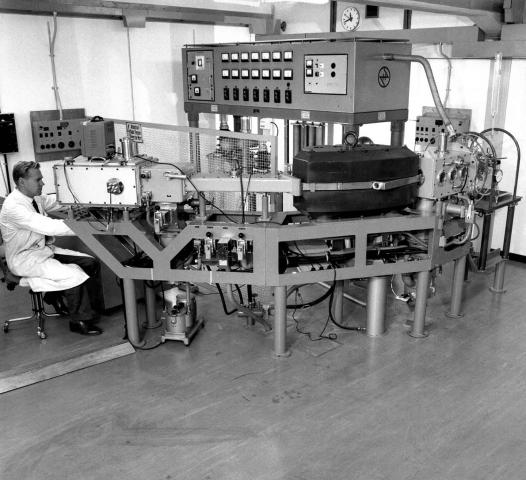
(image: The isotope separator in 1960)
Plans for an isotope separator are published in the proceedings of the International Symposium held in Vienna, May 1960. This isotope separator is built by CERN's Nuclear Chemistry Group (NCG) and used to measure the production rate of radionuclides produced in different targets irradiated with 600 MeV protons from a CERN Synchrocyclotron (SC) beam. Researchers observe high production rates showing that the SC would be the ideal machine for setting up a dedicated experiment for on-line production of rare isotopes.
CERN approves the online separator project
On 10 April 1963, a number of European nuclear physicists meet at CERN to discuss the isotope separator project. A first outline is presented in an internal nuclear physics division report.
A Working Party is set up and a series of meetings are held from May to September. In a memorandum dated 26 October 1964 the chairman of the Nuclear Structure Committee Torleif Ericson recommends the on-line isotope separator project to CERN and on 9 November the Working Party submit a formal proposal.
On 17 December 1964 the Director-General gives formal permission to the groups behind the proposal to carry out the experiment.
Synchrocyclotron shuts down
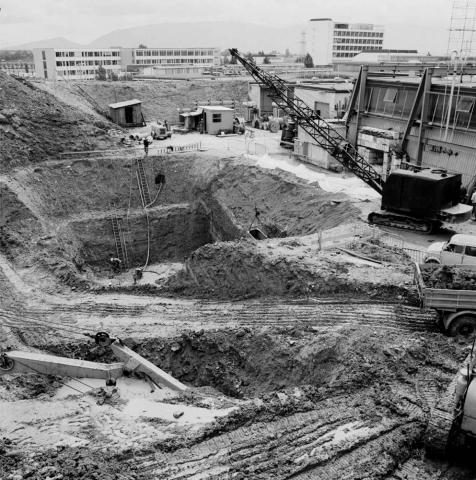
(image: excavation work for ISOLDE underground hall in 1966)
On 8 May 1966, the CERN Synchrocyclotron begins a long shutdown until mid-July. During this time major modifications are carried out as part of a programme to improve the capacity of the machine and its associated facilities. One of the main items of work during the shutdown is the construction of a new tunnel for an external proton beam line to the new underground hall for the ISOLDE experiments. This tunnel is constructed underground to keep external radiation levels down and the existing proton room is kept for experiments that use beams of lower intensity.
First proton beams at ISOLDE
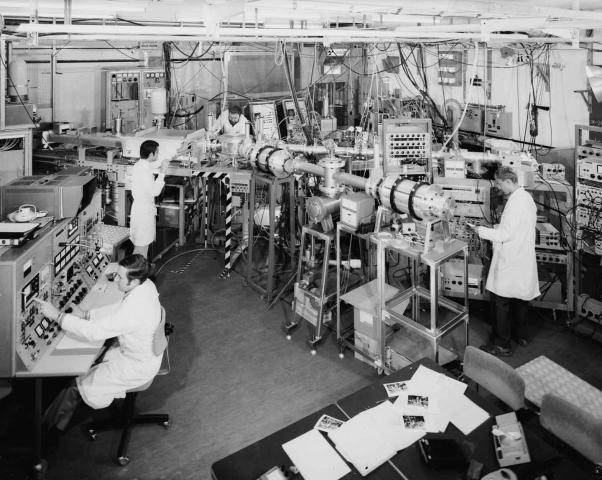
(image: ISOLDE experimental hall. The magnet of the ISOTOPE separator, the collection chamber and the control desk were placed in the same area as most of the experiments.)
The underground hall for ISOLDE is ready in 1967 and the first proton beam bombards the target on October 16. The first experiments are successful and prove that the online technique meets the expectations of the experimentalists. During the next year, a number of experiments produce short-lived isotopes of a several elements. The first paper is published early in 1969 and presents results for short-lived isotopes of the noble gases Ar, Kr, Xe and Rn and several other elements like Ag, Cd, I, Pt, Au, Hg, Po and Fr.
Plans to shut down the Synchrocyclotron
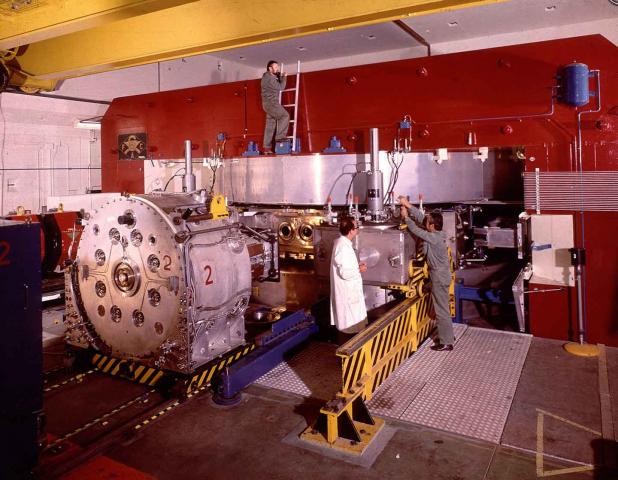
(image: The Synchrocyclotron with the rotating condenser )
The Synchrocyclotron (SC) is shut down for a major reconstruction in 1972, called the SC Improvement Programme (SCIP). An important part of the upgrade of the SC is to change the frequency system from one based on a tuning fork to a rotating condenser. The extraction system of the beam to ISOLDE is also improved, which means a beam intensity of about two orders higher can be delivered to the ISOLDE target.
First beams for ISOLDE target
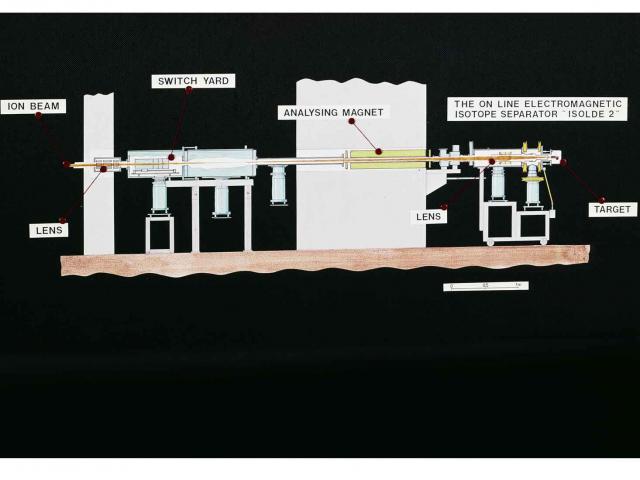
(image: The ISOLDE II experimental area)
In March 1974, the SC improvement programme is completed and the first beams are directed towards the ISOLDE targets.
The intensity increase of the external beam up to 1 μA together with new target designs hold their promises and give a considerable increase in the number of isotopes available for experiments.
A new target design and a new layout of the isotope separator is implemented. The target-ion-source unit is placed in the proton beam and the magnet of the isotope separator is placed close to the target. The separated isotopes are then directed towards the experimental setups via a switchyard, which allows researchers to experiment with isotopes of different mass numbers simultaneously.
The first experiment at the reconstructed ISOLDE Facility was performed on March 11, where a target-ion-source system for production of neutron deficient Cs isotopes was used to detect combined beta-delayed proton and alpha emission for the neutron deficient Cs isotopes with mass numbers 118 and 120.
New experiments in ISOLDE II
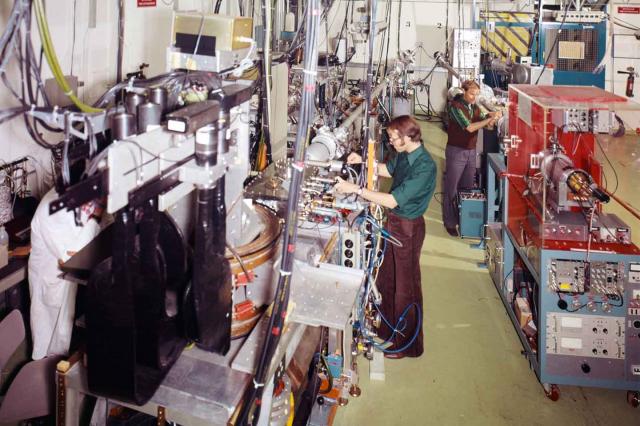
New experiments are installed at ISOLDE II and placed at the three main beam-lines. The photo shows the underground hall UR8 on April 6 1976, which only housed experimental installations. The control desk could be found one floor above.
ISOLDE III design is approved
To maximize the use of the Synchrocyclotron (SC) beam time and to meet the requests from the growing physics community using ISOLDE, the ISOLDE collaboration decides to build a second isotope separator of ultra-modern design. The separator design uses a two-stage separation (one 60 degree and one 90 degree magnet) in order to obtain a very high resolution. The target is placed in the SC vault and after the second magnet, the ion beam enters the proton hall, which serves as the new experimental area.
ISOLDE III, is approved at the CERN Research Board session in June 1983 and the final approval to start building the new separator is taken on 10 November of the same year.
The laser ion source, RILIS, is developed
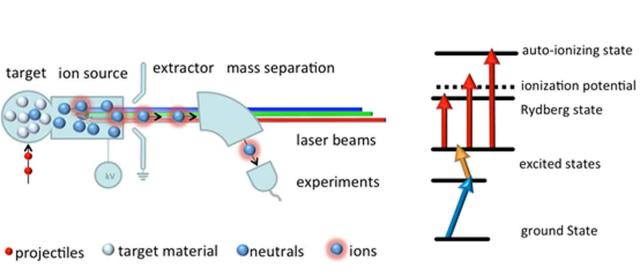
(image: The basic principle of the RILIS technique: Two laser beams tuned to transitions between atomic levels - blue and yellow arrows - excite the atoms and a third beam induces the ionization)
The traditional ion sources used at ISOLDE were based on surface ionization and ionization in a plasma. These techniques together with different target matrices gave a large variety of beams for more than 20 years. A major step in improving the purity of and the number of available elements came in 1989 with a new technique based on laser ionization.
A combination of laser beams at wavelengths tuned to the sequence of atomic transitions enables highly efficient resonance excitation and ionization of selected atoms. Isotopes of other elements of the same mass do not interact with the laser radiation. This type of ion source is referred to as a Resonance Ionization Laser Ion Source (RILIS) and is a very powerful tool for the efficient and selective production of radioactive ion beams. The initial off-line RILIS development is then followed by its successful on-line application for laser ionization of ytterbium isotopes at ISOLDE-III on 10 October 1990.
Pagination
- Previous page
- Current page 1
- Page 2
- Page 3
- Next page